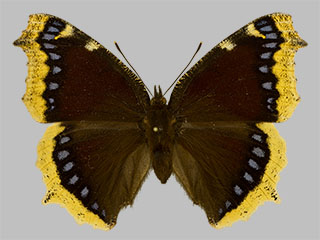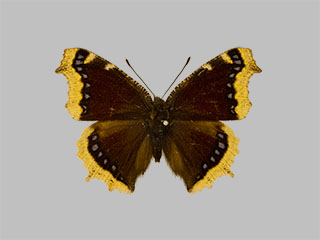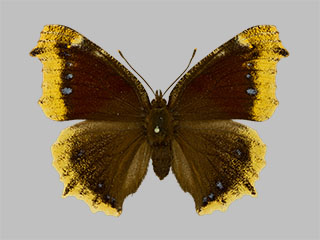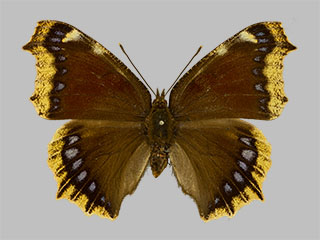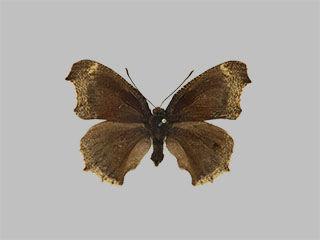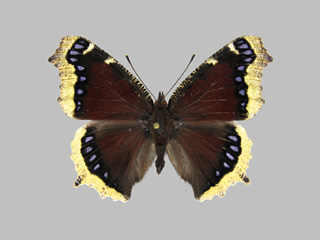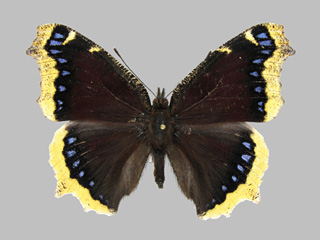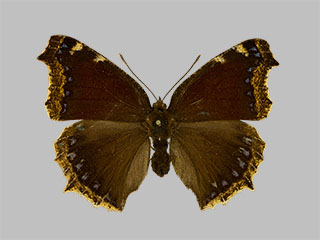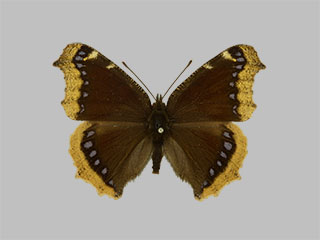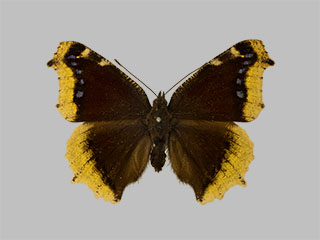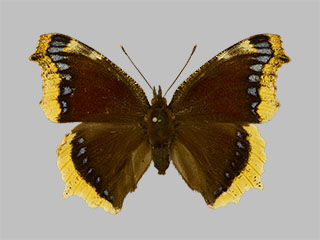 Camberwell BeautyNymphalis antiopa (Linnaeus, 1758)Mourning CloakCamberwell Beauties can vary greatly in size, but also in the colour and shape of the wing markings. The prepared
Camberwell BeautyNymphalis antiopa (Linnaeus, 1758)Mourning CloakCamberwell Beauties can vary greatly in size, but also in the colour and shape of the wing markings. The prepared  Camberwell BeautyNymphalis antiopa (Linnaeus, 1758)Mourning CloakCamberwell Beauties shown were photographed at the same scale:
Camberwell BeautyNymphalis antiopa (Linnaeus, 1758)Mourning CloakCamberwell Beauties shown were photographed at the same scale:
|
|
|
|
|
|
The two  Camberwell BeautyNymphalis antiopa (Linnaeus, 1758)Mourning CloakCamberwell Beauties of Norbert KondlaNorbert Kondla, both caught on 21 August 2006 in the Pend-d'Oreille Valley in the Canadian province of British Columbia, also show a good example of variation within the species:
Camberwell BeautyNymphalis antiopa (Linnaeus, 1758)Mourning CloakCamberwell Beauties of Norbert KondlaNorbert Kondla, both caught on 21 August 2006 in the Pend-d'Oreille Valley in the Canadian province of British Columbia, also show a good example of variation within the species:
 Camberwell BeautyNymphalis antiopa (Linnaeus, 1758)Mourning CloakCamberwell Beauty
Camberwell BeautyNymphalis antiopa (Linnaeus, 1758)Mourning CloakCamberwell Beauty
Nymphalis antiopa ssp. antiopa
[59 mm]
Catching:
Norbert KondlaNorbert Kondla leg.; Pend-d'Oreille Valley, British Columbia,  CanadaPend-d'Oreille Valley, British Columbia,
CanadaPend-d'Oreille Valley, British Columbia,  CanadaBritish Columbia,
CanadaBritish Columbia,  Canada
Canada Canada (21. August 2006)
Canada (21. August 2006)
 Camberwell BeautyNymphalis antiopa (Linnaeus, 1758)Mourning CloakCamberwell Beauty
Camberwell BeautyNymphalis antiopa (Linnaeus, 1758)Mourning CloakCamberwell Beauty
Nymphalis antiopa ssp. antiopa
[71 mm]
Catching:
Norbert KondlaNorbert Kondla leg.; Pend-d'Oreille Valley, British Columbia,  CanadaPend-d'Oreille Valley, British Columbia,
CanadaPend-d'Oreille Valley, British Columbia,  CanadaBritish Columbia,
CanadaBritish Columbia,  Canada
Canada Canada (21. August 2006)
Canada (21. August 2006)
Nymphalis antiopa var. escheriNymphalis antiopa var. escheri (Linnaeus, 1758)Nymphalis antiopa var. escheri Gramann, 1920
This Individual variationindividual variation described by August Gramann (1876-1936)August Gramann in 1920 has a very widespread black fringe on the forewings, which continues into the yellow border, leaving only yellow round spots. The blue spots are greatly reduced or have disappeared. On the hind wings, the yellow border is dusted with black and partially interspersed with black stripes.
August Gramann (1876-1936)August Gramann has described the butterfly not as a Individual variationindividual variation, but as a new A genetic or environmentally produced variation on the usual form of the speciesaberration.
 Camberwell BeautyNymphalis antiopa (Linnaeus, 1758)Mourning CloakCamberwell Beauty
Camberwell BeautyNymphalis antiopa (Linnaeus, 1758)Mourning CloakCamberwell Beauty
Nymphalis antiopa f. daubii
[Breeding image; 64 mm]
var. Daubi Stdfss., 48 Std. +37,5°, extremely
Collection: Museum Alexander Koenig, Bonn
Subcollection: ex coll. Missionshaus SVD Steyl (Eing.Nr.3/59)
Breeding: (July 1910)
This  Camberwell BeautyNymphalis antiopa (Linnaeus, 1758)Mourning CloakCamberwell Beauty, which originates from temperature experiments, partly matches August Gramann (1876-1936)August Gramann's description.
Camberwell BeautyNymphalis antiopa (Linnaeus, 1758)Mourning CloakCamberwell Beauty, which originates from temperature experiments, partly matches August Gramann (1876-1936)August Gramann's description.
On the naming of Individual variationindividual variation Nymphalis antiopa var. escheriNymphalis antiopa var. escheri (Linnaeus, 1758)Nymphalis antiopa var. escheri see Scientific Names.
Nymphalis antiopa var. grandisNymphalis antiopa var. grandis (Linnaeus, 1758)Nymphalis antiopa var. grandis Ehrmann, 1900
The Individual variationindividual variation described by George A. EhrmannGeorge A. Ehrmann in 1900 lacks the characteristic blue dorsal spots on the black pre-seam. The yellow margin is dusted brown.
Vanessa antiopa Linn. Var. grandis, ♀, nov. var.
The whole space of the upper side, except the yellow border and the submarginal black bar, is of a rich chocolate brown; the submarginal row of blue spots is wanting and the yellow border is greatly suffused with brown; under side normal. Female, ex. larva, in my collection.
Hab.-S.W. Penn'a.
 Camberwell BeautyNymphalis antiopa (Linnaeus, 1758)Mourning CloakCamberwell Beauty
Camberwell BeautyNymphalis antiopa (Linnaeus, 1758)Mourning CloakCamberwell Beauty
Nymphalis antiopa f.
[Breeding image; 66 mm]
Temperature experiments Karl Frings, Bonn: chrysalis 12 hours +6°C., 28 hours +38°C. 19 hours +6°C., 14 hours +37°C.
Collection: Museum Alexander Koenig, Bonn
Breeding:
Karl Frings (1874-1931)Karl Frings; Bonn,  GermanyBonn,
GermanyBonn,  Germany
Germany Germany (1903)
Germany (1903)
This  Camberwell BeautyNymphalis antiopa (Linnaeus, 1758)Mourning CloakCamberwell Beauty partly matches George A. EhrmannGeorge A. Ehrmann's description, but the blue spots have not disappeared, but are much smaller.
Camberwell BeautyNymphalis antiopa (Linnaeus, 1758)Mourning CloakCamberwell Beauty partly matches George A. EhrmannGeorge A. Ehrmann's description, but the blue spots have not disappeared, but are much smaller.
The description of Nymphalis antiopa var. grandisNymphalis antiopa var. grandis (Linnaeus, 1758)Nymphalis antiopa var. grandis is basically similar to A genetic or environmentally produced variation on the usual form of the speciesaberration Nymphalis antiopa f. dorfmeisteriNymphalis antiopa f. dorfmeisteri (Linnaeus, 1758)Nymphalis antiopa f. dorfmeisteri (see Forms/Aberrations).
The Nymphalis antiopa var. grandisNymphalis antiopa var. grandis (Linnaeus, 1758)Nymphalis antiopa var. grandis-Specimen of the first description (name-bearing or eponymous type)Type specimen has unusually small hind wings and is comparatively small in stature with a wingspan of approx. 55mm (see Butterflies of America; Nymphalis a. antiopa (Linnaeus, 1758); (Mourning Cloak); Type Specimens).
On the naming of Individual variationindividual variation Nymphalis antiopa var. grandisNymphalis antiopa var. grandis (Linnaeus, 1758)Nymphalis antiopa var. grandis see Scientific Names.
Nymphalis antiopa var. pusillaNymphalis antiopa var. pusilla (Linnaeus, 1758)Nymphalis antiopa var. pusilla Strand, 1901
Described by the Norwegian Insect scientistEntomologist Embrik Strand (1876-1947)Embrik Strand in 1901, this Individual variationindividual variation is smaller and has a rusty yellow margin:
Vanessa antiopa ab. pusilla n.
Much smaller than usual, the fringe dark rusty yellow. - Obtained by breeding.
Embrik Strand (1876-1947)Embrik Strand has described the butterfly not as a Individual variationindividual variation, but as a new A genetic or environmentally produced variation on the usual form of the speciesaberration.
 Camberwell BeautyNymphalis antiopa (Linnaeus, 1758)Mourning CloakCamberwell Beauty
Camberwell BeautyNymphalis antiopa (Linnaeus, 1758)Mourning CloakCamberwell Beauty
Nymphalis antiopa ssp. antiopa
[56 mm]
Collection: Museum Alexander Koenig, Bonn
Catching:
Nürnberg, Bavaria,  GermanyNürnberg, Bavaria,
GermanyNürnberg, Bavaria,  GermanyBavaria,
GermanyBavaria,  Germany
Germany Germany
Germany
This  Camberwell BeautyNymphalis antiopa (Linnaeus, 1758)Mourning CloakCamberwell Beauty from Nürnberg, Bavaria,
Camberwell BeautyNymphalis antiopa (Linnaeus, 1758)Mourning CloakCamberwell Beauty from Nürnberg, Bavaria,  GermanyNürnberg fits well with Embrik Strand (1876-1947)Embrik Strand's description.
GermanyNürnberg fits well with Embrik Strand (1876-1947)Embrik Strand's description.
On the naming of Individual variationindividual variation Nymphalis antiopa var. pusillaNymphalis antiopa var. pusilla (Linnaeus, 1758)Nymphalis antiopa var. pusilla see Scientific Names.
Nymphalis antiopa var. thomsoniiNymphalis antiopa var. thomsonii (Linnaeus, 1758)Nymphalis antiopa var. thomsonii Butler, 1887
Described by the British Insect scientistEntomologist, arachnologist and ornithologist Arthur Gardiner Butler (1844-1924)Arthur Gardiner Butler in 1887, this Individual variationindividual variation is darker than the Nominiform or (new) nominotypic taxon: Taxon defined by the same name-bearing type as the higher-ranking taxon to which it itself belongs.Type Species (chocolate-brown). It shows a pale, straw-coloured seam that is spotted black, especially on the veins. Butler describes many other characteristics, such as special yellow spots Butler, 1887 - Description of a new Butterfly allied to Vanessa antiopa.
The following form is less likely to be a variety of V. antiopa than the others (Meant are  Nymphalis antiopa ssp. lintneriiNymphalis antiopa ssp. lintnerii (Linnaeus, 1758)Nymphalis antiopa ssp. lintnerii and
Nymphalis antiopa ssp. lintneriiNymphalis antiopa ssp. lintnerii (Linnaeus, 1758)Nymphalis antiopa ssp. lintnerii and  Nymphalis antiopa f. hygiaeaNymphalis antiopa f. hygiaea (Linnaeus, 1758)Nymphalis antiopa f. hygiaea (see Subspecies)), since the modification of the border is not uniform and at the same thime is far more remarkable;
Nymphalis antiopa f. hygiaeaNymphalis antiopa f. hygiaea (Linnaeus, 1758)Nymphalis antiopa f. hygiaea (see Subspecies)), since the modification of the border is not uniform and at the same thime is far more remarkable;
... Vanessa Thomsonii, n. sp.
Colouring darker than in V. antiopa; primaries with pale straw-coloured outer border, about as wide as in that species, but heavily mottled with black, specially upon the veins; a subapical oblique yellow spot followed by five smaller decreasing and less distinct spots of the same colour, but followed by whitish scales, the whole forming an elbowed series; costa speckled with yellowish in the centre: secondaries with the basal three fifths of the same dark dull chocolate-brown as the primaries, the external two fifths, which are separated by a sharply defined, regularly dentate-sinuate line from costa to anal angle, straw-yellow, rather heavily mottled with black, but densely so upon the tail.
British Honduras ? (coll. Hon. W. De Rothschild).
It will be seen that the outer border of the secondaries in this insect is twice the width of that of the primaries.
The fringe width of the hind wings is twice the width of the forewings. The wingspan is 67 millimetres.
The specimen he analysed comes from a collection by Walter De Rothschild (1868-1937)Walter De Rothschild with catches from  Honduras
Honduras Honduras and the former British colony
Honduras and the former British colony  Guyana
Guyana Guyana. Arthur Gardiner Butler (1844-1924)Arthur Gardiner Butler assumes
Guyana. Arthur Gardiner Butler (1844-1924)Arthur Gardiner Butler assumes  Honduras
Honduras Honduras as the probable place of capture.
Honduras as the probable place of capture.
Arthur Gardiner Butler (1844-1924)Arthur Gardiner Butler has described the butterfly not as a Individual variationindividual variation, but as a new Species. It is partly reminiscent of the A genetic or environmentally produced variation on the usual form of the speciesaberration  Nymphalis antiopa f. hygiaeaNymphalis antiopa f. hygiaea (Linnaeus, 1758)Nymphalis antiopa f. hygiaea (see Photos of pinned Camberwell beauties (Nymphalis antiopa): Nymphalis antiopa f. hygiaea). Classification as Individual variationindividual variation occasionally occurs, e.g. in Gönner, 1928 - Der Trauermantel und sein Formenkreis.
Nymphalis antiopa f. hygiaeaNymphalis antiopa f. hygiaea (Linnaeus, 1758)Nymphalis antiopa f. hygiaea (see Photos of pinned Camberwell beauties (Nymphalis antiopa): Nymphalis antiopa f. hygiaea). Classification as Individual variationindividual variation occasionally occurs, e.g. in Gönner, 1928 - Der Trauermantel und sein Formenkreis.
Nymphalis antiopa ssp. asopos f.Nymphalis antiopa ssp. asopos f. Fruhstorfer, 1909Nymphalis antiopa ssp. asopos f.
Nymphalis antiopa ssp. asopos f.
[60 mm]
Collection: Museum Alexander Koenig, Bonn , Kt. Nr. 162/a1, ZFMK 76/64 Boppard
This  Camberwell BeautyNymphalis antiopa (Linnaeus, 1758)Mourning CloakCamberwell Beauty corresponds in part to Arthur Gardiner Butler (1844-1924)Arthur Gardiner Butler's description.
Camberwell BeautyNymphalis antiopa (Linnaeus, 1758)Mourning CloakCamberwell Beauty corresponds in part to Arthur Gardiner Butler (1844-1924)Arthur Gardiner Butler's description.
On the naming of Individual variationindividual variation Nymphalis antiopa var. thomsoniiNymphalis antiopa var. thomsonii (Linnaeus, 1758)Nymphalis antiopa var. thomsonii see Scientific Names.
Nymphalis antiopa var. ziegleriNymphalis antiopa var. ziegleri (Linnaeus, 1758)Nymphalis antiopa var. ziegleri Gramann, 1920
This Individual variationindividual variation described by August Gramann (1876-1936)August Gramann in 1920 has a narrower yellow border, blue spots that have disappeared and lengthened, as well as lengthened, blurred light-coloured spots on the leading edge of the forewings.
August Gramann (1876-1936)August Gramann has described the butterfly not as a Individual variationindividual variation, but as a new A genetic or environmentally produced variation on the usual form of the speciesaberration.
 Camberwell BeautyNymphalis antiopa (Linnaeus, 1758)Mourning CloakCamberwell Beauty
Camberwell BeautyNymphalis antiopa (Linnaeus, 1758)Mourning CloakCamberwell Beauty
Nymphalis antiopa f.
[Breeding image; 69 mm; Male]
Vanessa Antiopa aberr.
Collection: Museum Alexander Koenig, Bonn
Breeding:
A. VoelshowA. Voelshow; Schwerin, Mecklenburg-Vorpommern,  GermanySchwerin, Mecklenburg-Vorpommern,
GermanySchwerin, Mecklenburg-Vorpommern,  GermanyMecklenburg-Vorpommern,
GermanyMecklenburg-Vorpommern,  Germany
Germany Germany (July 1896)
Germany (July 1896)
This  Camberwell BeautyNymphalis antiopa (Linnaeus, 1758)Mourning CloakCamberwell Beauty corresponds in part to August Gramann (1876-1936)August Gramann's description.
Camberwell BeautyNymphalis antiopa (Linnaeus, 1758)Mourning CloakCamberwell Beauty corresponds in part to August Gramann (1876-1936)August Gramann's description.
On the naming of Individual variationindividual variation Nymphalis antiopa var. ziegleriNymphalis antiopa var. ziegleri (Linnaeus, 1758)Nymphalis antiopa var. ziegleri see Scientific Names.




